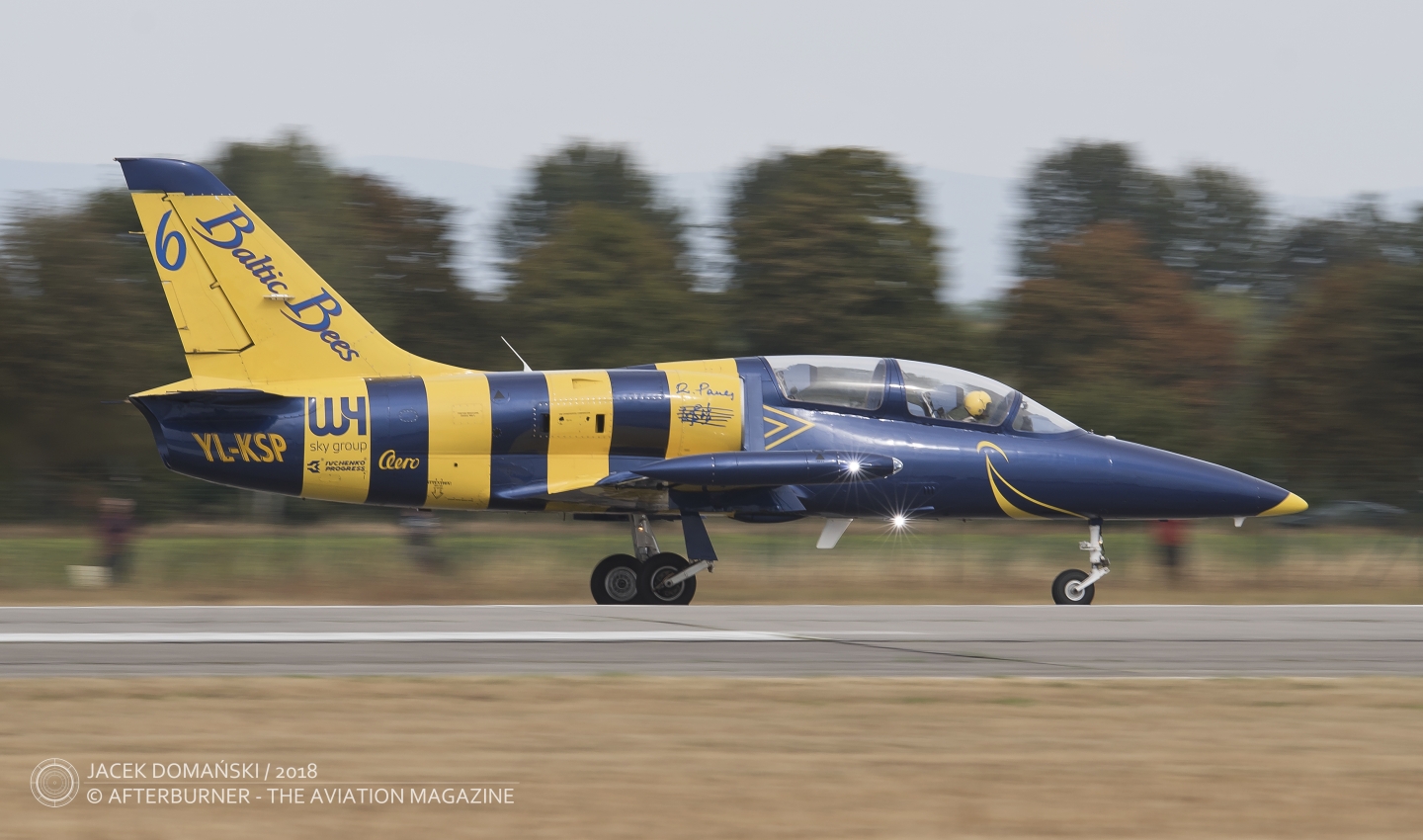 During the six days of its operation more than 450,000 people visited the 13th edition of the biennial Russian biggest aviation event, the International Aviation and Space Salon MAKS-2017.
During the six days of its operation more than 450,000 people visited the 13th edition of the biennial Russian biggest aviation event, the International Aviation and Space Salon MAKS-2017.
The specialised public and other visitors could follow the flight programme with 90 participating aircrafts in solo and team displays, the presentation of the aviation and space industry companies and manufacturers at the trade fair grounds and pavilions, and the extensive static display of 116 aircraft.
What attracted most all the foreign visitors were certainly the aircrafts from the current inventory of the Russian Air Force, the static display of them included the fighters, transport and utility aircraft and even the strategic bombers. This presentation was probably the most appreciated one, with the vast crowd of spectators gathered around them all the time during the opening hours of the Salon.
Obviously, this wasn´t the sole interesting static display at MAKS-2017 and the military equipment there was accompanied with the variety of historical, passenger, transport and test airplanes and helicopters, including a few prototypes and newest designs. There were also two significant public premieres at the static display – the 4++ generation MiG-35 fighter and Mi-171Sh-VN special operations helicopter.
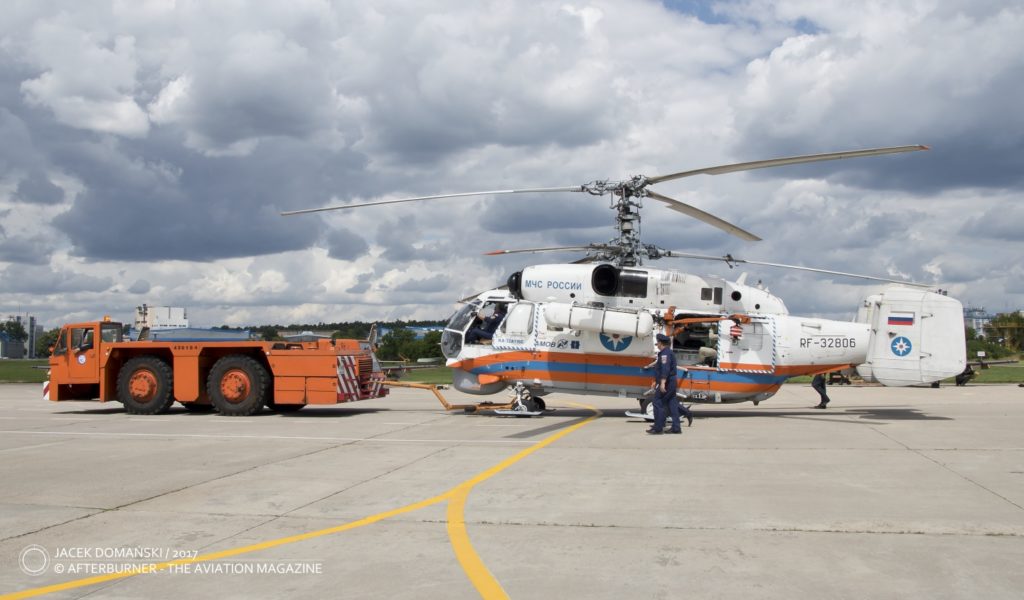
The highlights among the historical aircraft shown at the Salon were, without any doubts, the Il-2 ´Sturmovik´ recently restored to the airworthy condition and two huge iconic constructions from the Soviet era – supersonic airliner Tu-144 and Myasishchev VM-T ´Atlant´ heavy transport airplane.
Another part of the static exhibition that received a great deal of attention was the exposition of ´Russian Helicopters´ (“Вертолеты России”) company, with the wide presentation of the currently manufactured and offered for sale Russian-made helicopters.
Using the purely subjective choice criteria, there is a short review of some interesting aircraft that could be seen at the MAKS-2017 static display:

MiG-35 / МиГ-35 fighter
Ten years from the beginning of the development of this 4++ generation fighter, the MiG-35 has its public premiere at the Salon. Officially presented and offered for sale since the January 2017, this new development is a chance for the RSK MiG company to recover from the lately reported issues. Being more the upgrade of the existing MiG-29 variants than the brand-new development, the final version of the MiG-35 airplane has the equipment less advanced than it was expected from the evaluated prototypes and targeted mostly towards the export customers.
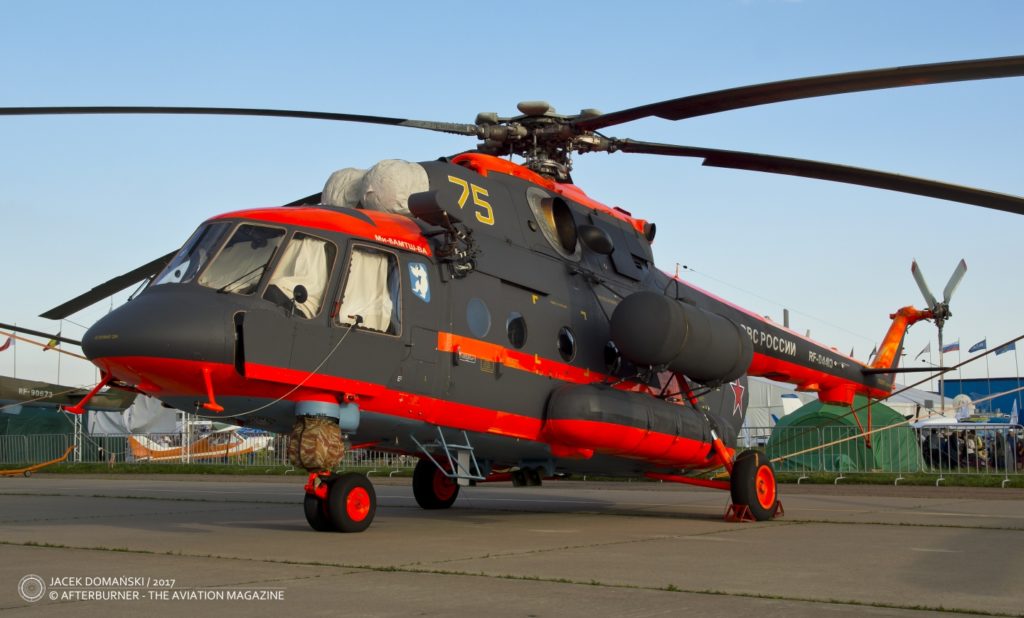
Mi-8AMTSh-VA / Ми-8АМТШ-ВА ´Arctic Helicopter´
The Mi-8/17 family is known from many specialised variants, and one of the latest is the aircraft presented at MAKS-2014 and designed specially to operate and survive in harsh weather conditions of the Arctic and Far North areas. The ´Arctic Helicopter´, being the advanced Mi-8AMTSh modernization, is manufactured for the Russian Ministry of Defence purposes and is capable to perform a variety of services as ambulance, transportation and landing operations, aerial reconnaissance and targeting, and search and rescue. Mi-8AMTSh-VA can work in the exceptional Arctic conditions that include the polar night, low temperatures, lack of radio signal and long distance from the maintenance centres. Among the main features of the Arctic variant are the special heating equipment allowing to start the helicopter quickly even if stored outside at the temperature as low as – 60°C, the range extended to 1,300 km and flight duration of 7 hours – thanks to the additional fuel tanks, radio direction-finding device and enhanced radar and night vision equipment.
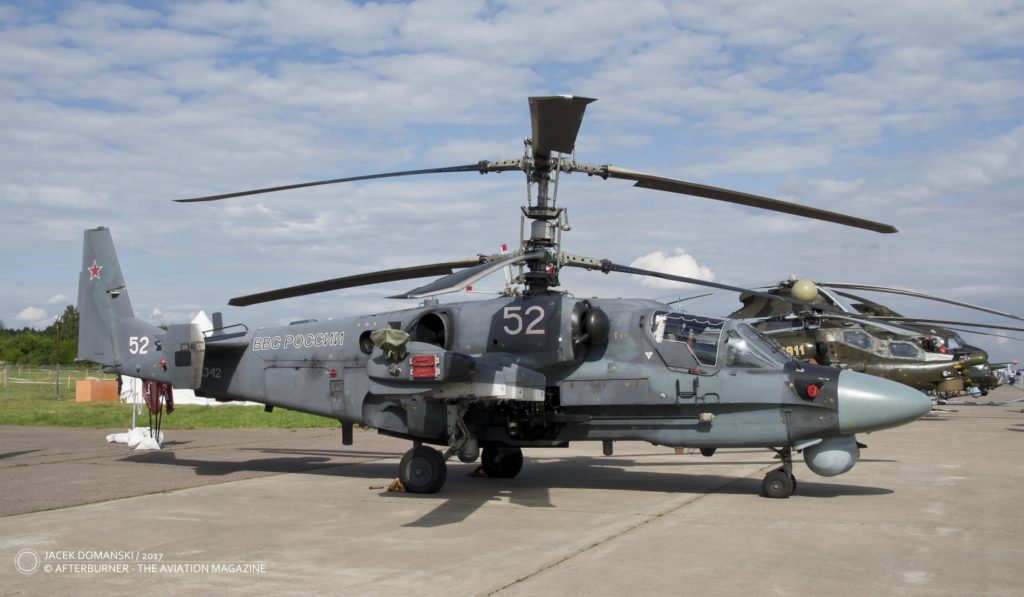
Ka-52K ´Katran´/ Ка-52К “Катран” combat helicopter
´Katran´ is the naval variant of the Ka-52 Alligator combat helicopter, previously intended to operate from the French-built Mistral-class amphibious assault ships. The first prototype made its maiden flight in 2015. Ka-52K operational capabilities include combat, target acquisition and designation, maritime patrol and convoy escort missions. In 2016 the Ka-52Ks, based on board of ´Admiral Kuznetsov´ aircraft carrier, took an active part in the Russian operation in Syria.
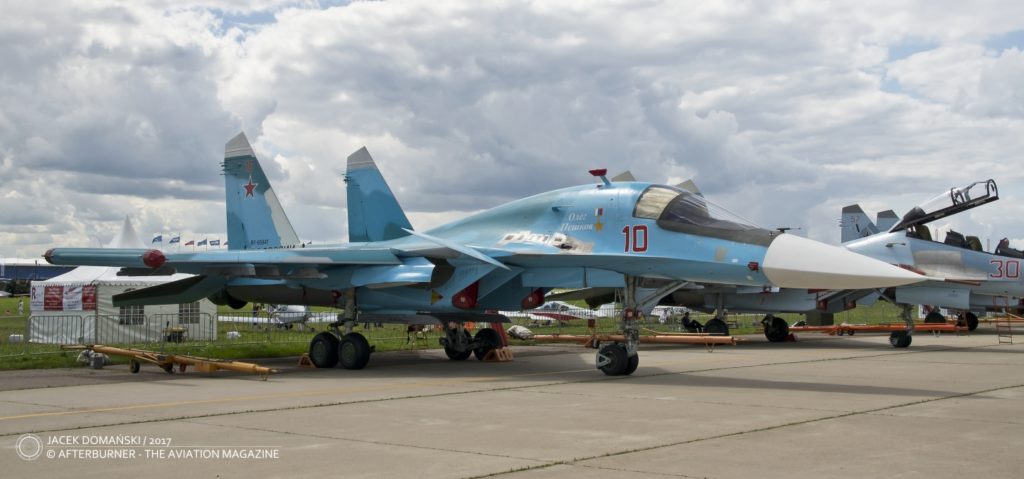
Sukhoi Su-34 / Сухой Су-34 fighter-bomber
Su-34 is the twin-engine and twin-seat multipurpose fighter-bomber, introduced into service in 2014. The aircraft is characteristic by its design, with the crew members seating side by side and the large cabin designed to maximize the crew comfort during the long-distance missions and the development in the remote airbases.
There are many rumours spreading around, regarding the Su-34 non-standard equipment and some of them are they are partially true. There is really a toilet in the cockpit – but if you expected a kind of flush or dry toilet like the ones installed in the airliners, you´re completely wrong as it´s just a kind of the compact pissoir with the small tank. The ´kitchen´ means the small microwave oven and vacuum bottle. The aircraft is also equipped with the additional electric energy generator. And that´s all regarding those rumours.
There were two Su-34s exhibited at the MAKS-2017 static display. One of them was ´number 10´ airplane, named after Lieutenant-Colonel Oleg Peshkov, the Russian pilot killed in Syria in November 2015. Peshkov´s Su-24 was shot down by a Turkish fighter jet, both Peshkov and the second crew member Konstantin Murakhtin ejected from the airplane, but Peshkov was killed by militants as he descended on a parachute.
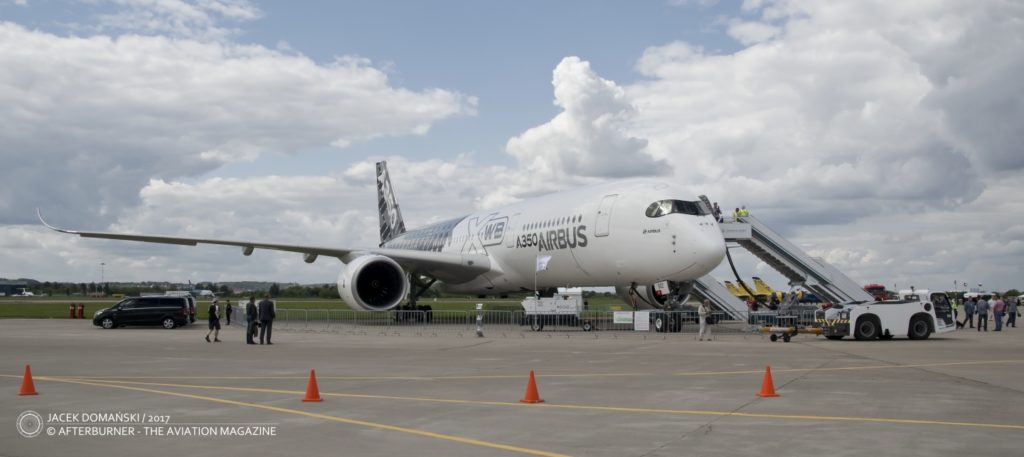
Airbus A350-900
There would be no aviation trade fair without the presentation of the newest airliners. One of them was the member of all-new Airbus A350 XWB family, the A350-900. The airplane presented during the Salon was one of the five A350-900 built for the tests and certification purposes, with the measurement equipment on board. In the press release issued by Airbus at the opportunity of A350 presentation at the Salon, the cooperation with the Russian aviation industry was strongly mentioned – ECAR engineering centre in Moscow was involved in the A350 design and creation and VSMPO-Avisma Corporation is the main supplier of titanium for that aircraft (the A350 share of titanium is about 14%). The airliner was not only a part of the static display, with the possibility to visit the cabin, but also took part in the flying programme.

Tupolev Tu-22M3 / Туполев Ту-22М3 (NATO reporting name: Backfire)
Tu-22M3 ´red 36´ that was a part of the exhibition of current Russian Air Force airplanes is reported as the Afghanistan war veteran. According to the information published in the Russian aviation magazine „Авиация и Время“ (05-1998), at the drawing of ´red 36´, this is one of the two Tu-22M3 aircrafts flown by Д. Дудаев / D. Dudayev, during his combat missions in Afghanistan in 1986/87. Yes, the same Dudayev that later was the first President of the Chechen Republic of Ichkeria (and then officially denied his participation in the combat missions over Afghanistan).

Tupolev Tu-160M1 ´White swan´ / Туполев Ту-160M1 „Белый лебедь“ (NATO reporting name: Blackjack)
Tu-160 is the supersonic, variable-sweep wing heavy strategic bomber that entered service in 1987. It is also the largest, the heaviest and the fastest combat airplane in the world; considered also as the largest and heaviest supersonic airplane ever built.
The aircraft presented at MAKS-2017 was named “Николай Кузнецов” / ´Nikolai Kuznetsov´, after the airplane and rocket engines designer, Nikolai Dmitriyevich Kuznetsov. And what is powering the Tu-160s are exactly the four NK-32 engines, designed by Kuznetsov and his construction bureau.
´Nikolai Kuznetsov´ is one of the first modernized Tu-160s, the general overhaul and modernisation works were finished in 2016, in Kazan Aviation Plant. This aircraft was presented several times during the aviation and media events in Russia and was also participating in some long-distance flights performed by Russian Air Force around the NATO countries – as for example was the flight along the French coastline in February 2017.

Myasishchev VM-T ´Atlant´ / Мясищев ВМ-Т „Атлант“
VM-T was the heavy transport airplane, built in early 1980s by the Myasishchev construction bureau, based on their earlier constructions.
The story of this heavy transport airplane begins in 1950s when the first Myasishchev M-4 ´Molot´ (´Hammer´) strategic bombers were built. The development followed by the improved 3M variant and then by the conversion of the existing bombers into the fuel tankers (that remained in service until the mid-1990s).
In late 1970s the growing Soviet space programme needed the airlifter capable of shuttling the huge elements of the space rockets to the launch pad. The Antonov design office, currently working on An-124 project, was asked to build the aircraft fulfilling the needs of the space industry – it would be later known as An-225. However, at the time the new space prototypes Energia LV and Buran were completed, both An-124 and An-225 projects were still in development. The quick solution of rebuild some 3M tankers into the airlifter was offered by the Myasishchev bureau. Three 3MN-2 tank airplanes were adopted into this role between 1978 and 1981, undergoing so many modifications and changes that some consider VM-T as the completely new airplane rather than the evaluation of M-4/3M bomber.
Finally just two ´Atlant´ airplanes were used for the space industry purposes, both performed more than 150 flights to Baikonur spaceport. The name ´VM-T´ stands for ´Vladimir Myasishchev – Transport´ and was given to the airplane after the death of V. Myasishchev in 1978.
During the MAKS-2017 the VM-T strategic lifter was presented together with the Energia oxygen tank mounted on the back.

Tupolev Tu-144D / Туполев Ту-144Д
Tu-144 was one of the two supersonic airliners design that finalized their development by entering the commercial service. Tu-144 was often nicknamed ´Konkordskiy´ due to the similar look and overall concept to the Anglo-French ´Concorde´ supersonic airliner.
The development and commercial use faced many technical problems and the passenger service was suspended in 1978, after only 55 commercial passenger flights. Some Tu-144 were then used as a freight or test aircrafts until the final retirement in 1999.
One of the surviving aircraft was exhibited during MAKS-2017 – 77115 („004Д”), the modernized variant of the original design, with the RD-36-51A engines, and being the last build Tu-144 (the production, despite the suspension of the passenger flights, was continued until 1983). Another surviving Tu-144 could be also spotted at the Gromov Flight Research Institute grounds at Zhukovsky airport (outside the public accessible area of MAKS-2017).

Mikoyan Project 1.44 / МиГ-1.44 (NATO reporting name: Flatpack)
This interesting aircraft is one of two prototypes built as a part of 1.44/1.42 project of the advanced fifth generation fighter lead by the Mikoyan design bureau. This project was a part of Soviet I-90 / И-90 („истребитель 1990-х годов“ – ´the fighter of the 1990s´) programme and was intended to be the Soviet answer for the American ´Advanced Tactical Fighter´ development, that, finally, resulted in the F-22 Raptor fighter.
The Mikoyan project started parallelly, but due to the political situation at the end of the 80s and the beginning of the 90s. and the following problems with funding the project, the development was much slower than the ATF one. The maiden flight of so-called MiG 1.44 was made in 2000, nine years behind the original schedule and the project was shortly cancelled. Despite the fact of the official cancellation of the further development and the following declassification of the aircraft itself, the advanced materials, design and technology used with the 1.44 are still partly classified.
The prototype was exhibited at MAKS-2017 amid the increased security and with the limited possibility of taking photographs.
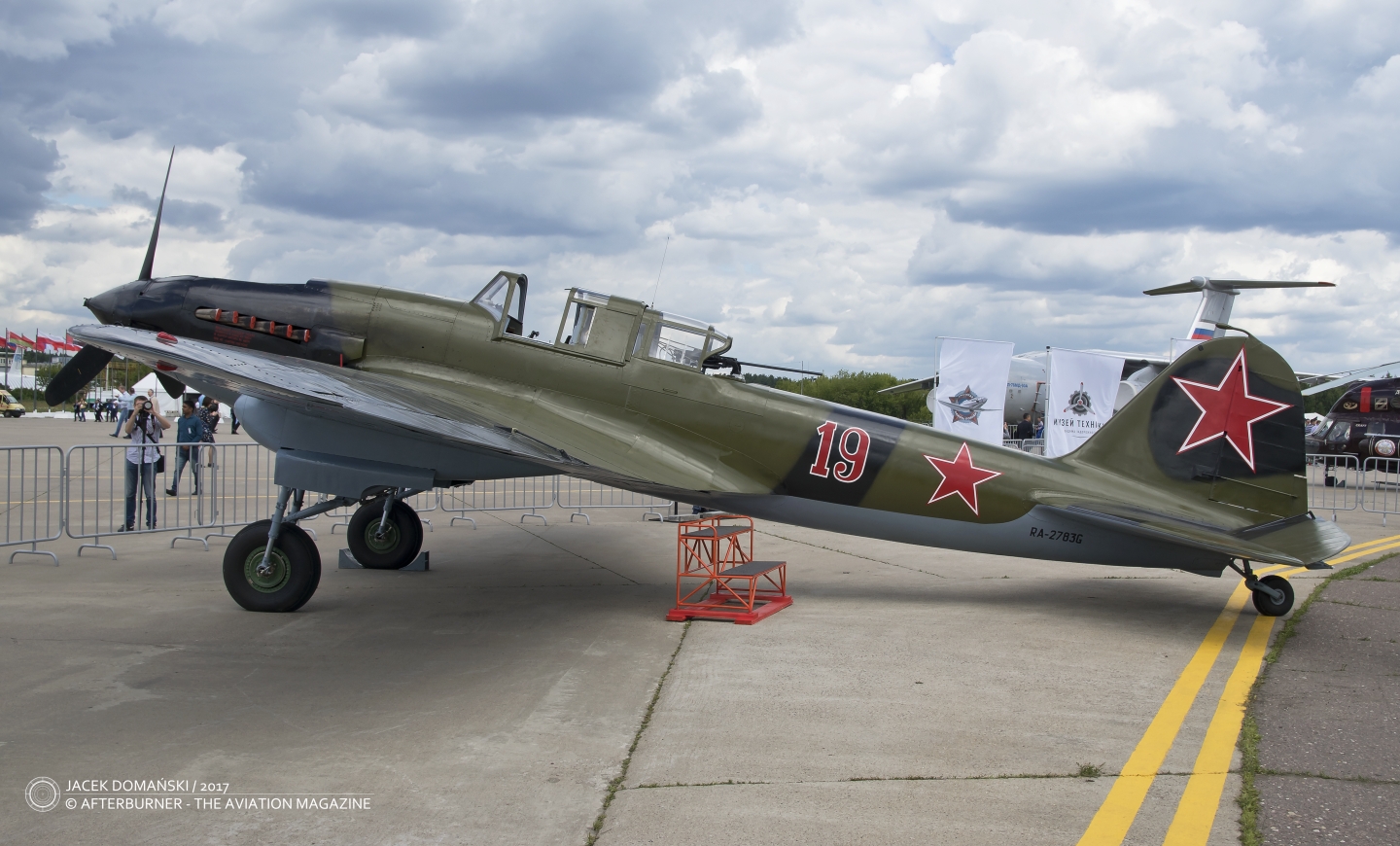
Ilyushin Il-2 / Ильюшин Ил-2
The second Il-2 in the world recently restored to the airworthy condition could also be seen during MAKS-2017. This aircraft, with the crew V. Skopintsev (pilot) and V. Gumennoy (gunner), was damaged during the air raid near Murmansk in November 1943. Skopintsev managed to belly landing his Sturmovik on the frozen surface of Kryvoe lake, the crew managed to escape but the airplane sank to the bottom of the lake.
Skopintsev´s Il-2, still lying in the Kryvoe lake, was localised in 2011, at the depth of 20 meters. In 2015 the aircraft was recovered from the lake and moved to Novosibirsk for restoration works performed by „Авиареставрация“ company and Siberian Aeronautical Research Institute (СибНИА), with the cooperation of several other Russian companies, ´Wings of Victory Foundation´ and pilot´s relatives.
After more than 70 years in the lake, the restored Il-2 made the maiden flight on 16th June 2017. The aircraft is now powered by the Allison engine and having the same 46th ShAP markings as used in 1943.



